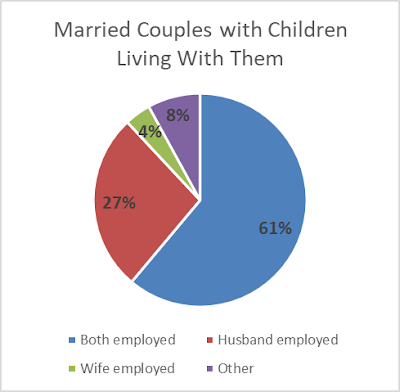Several readers on social media expressed curiosity on how common single income families are and what their place within the distribution of household incomes is, so I turned to the US Census to find out. I found some answers in Census Table FG2 for 2021, which covers "Opposite-Sex Married Couple Family Groups, by Family Income, and Labor Force Status of Both Spouses"
The census found the US has 63 million families consisting of opposite sex married couples, of which 24 million have children under 18 living at home with them. The 24 million families with at least one child under 18 living at home with them seemed like the relevant group for the question at hand, so I looked deeper at that data.
Among that 24 million, 61% had both husband and wife employed, 27% had only the husband employed, 4% had only the wife employed, and 8% fell into the "other" bucket. "Other" consisted of 1.9 million families of which 552k were families in which neither husband nor wife was in the labor force, and the other 1.4 million were families in which one or both spouses were temporarily unemployed but still in the labor force. Since those families were in a temporary situation which might or might not persist, it seemed unfair to class them in the other three stable employment categories.
The Census also provides data about how much family income these different families have. However, more than half the families fall in the top group: $100k/yr and above
This makes it hard to break the households into useful groupings, but I did my best. The overall result is: far from being a luxury lifestyle, single income families make up the majority of the lowest income group and half of the second lowest, while single income families are the least represented among families making over $100k/yr.
For single income families with only the mother working and only the father working, the distribution across income bands was pretty similar, though the families where the wife was the single income were slightly more likely to belong to the lower income bands.Two income families were about twice as likely to be making over $100k.
It's not possible to tell from this data how these families chose their income structure, but it certainly appears to be the case that single earning marriages are not an approach followed only by the affluent.





No comments:
Post a Comment